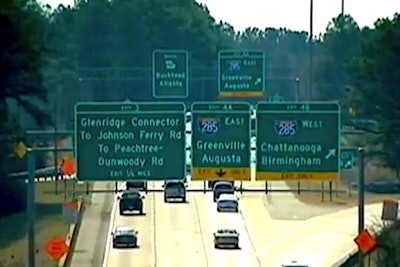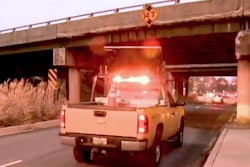 Georgia is planning a $1 billion update to the Interstate 285 and Georgia State Route 400 interchange.
Georgia is planning a $1 billion update to the Interstate 285 and Georgia State Route 400 interchange.Deficient roads in Georgia costs the state’s motorists nearly $8 billion in additional vehicle operating costs and expenses related to safety and congestion, according to a report by The Road Improvement Program.
TRIP held a dual press conference in Atlanta and Columbus in announcing its “Georgia Transportation by the Numbers: Meeting the State’s Need for Safe and Efficient Mobility” report Feb. 18.
The organization calculated the motorists’ costs for the Georgia’s largest urban areas including Athens, Atlanta, Augusta, Columbus, Gainesville, Macon, and Savannah. For vehicle operating costs, the estimated total is $1.7 billion; safety costs are $2.4; and the congestion-related figure is $3.8 billion.
“Motorists expect and deserve safe, well-maintained roads and bridges no matter if they are traveling on the Interstates or rural roads,” said Garrett Townsend, public affairs direct for AAA- The Auto Club Group. “Legislators must act to provide a sustainable solution to ensure that Georgia can continue to make necessary infrastructure investments that will benefit all travelers.”
TRIP says $378 billion in goods are shipped from Georgia, with $413 billion in goods are shipped into the state. Most of the shipments are via truck.
Between 2008 and 2012, the federal government provided $1.23 for road improvements for every $1 the state paid in federal motor fuel fees. The state is planning a $1 billion update to the Interstate 285 and Georgia State Route 400 interchange, which will be the most expensive project in Georgia Department of Transportation’s history.
Here is a breakdown of TRIP’s findings for roads and bridges in Georgia.
Major urban roads
- 10% have pavements in poor condition
- 39% are rated in mediocre or fair condition
- 51% are rated in good condition
Bridges
- 16% show significant deterioration or do not meet modern design standards
- 5% bridges structurally deficient*
- 11% bridges functionally obsolete*
*A structurally deficient bridge has significant deterioration of the bridge deck, supports, or other major components and is often closed or offers limited access to large vehicles, TRIP says. A functionally obsolete bridge no longer meets current design standards.








